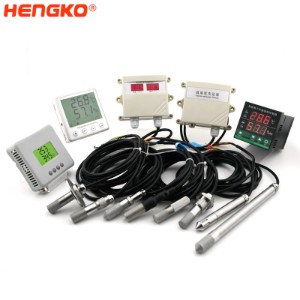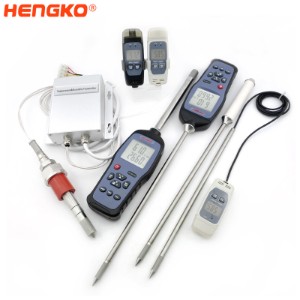It is so Important for Concrete Temperature And Humidity Monitoring Under Severe Weather Conditions
Weather conditions have a significant impact on the curing and strength of concrete. In cold weather, concrete cures more slowly, which reduces its strength. For hot weather concrete, problems can occur when moisture is removed from the concrete slab too quickly. This needs to be monitored by accurate temperature and humidity sensors to ensure that the cement is undergoing the correct curing process.
1. Hydration of concrete
When aggregates such as sand and gravel are mixed with cement and water, heat increases with them. The heat generated in this exothermic reaction is called the heat of hydration. The force of hydration is what causes concrete to harden.
During the hydration process, different chemical reactions usually occur simultaneously. These reactions result in "hydration products". These hydration products cause particles of sand, gravel, and other components to stick together and form concrete blocks.
2. Five stages of concrete thermal evolution
The thermal evolution in concrete is a complex process that has a significant impact on the strength of concrete. This process is divided into 5 different stages. Each stage has a specific timeline and chemical reaction, depending on the concrete mixture.
a. Initial reaction.
The first stage of the hydration process will begin shortly after the water is poured onto the cement. Then, a sudden increase in temperature is expected. This will occur quickly and only last about 15-30 minutes, depending on the type of cement used.
b. Dormancy period.
After the initial reaction, the compound will cover the surface of the cement particles, which will result in a slower rate of hydration. When this happens, it is the second phase of the thermal evolution of the concrete, also known as the induction phase, which is the time of penetration when the concrete has not yet hardened, and the transport and placement of the concrete need to be completed during this phase.
c. Period of force acceleration.
In the third stage, the concrete begins to gain strength and thus solidify, turning into a hard and solid mass. The heat of hydration increases moderately until it reaches its highest point. Temperature and humidity conditions at this time are monitored using temperature and humidity sensors, allowing the concrete to gradually set and reach the proper range. Hengko's multi-combination temperature and humidity products meet a wide range of customer needs, such as offering a variety of high-quality digital temperature and humidity sensor probes: To commission a transmitter, you need a connectable probe. For example, use a probe with a high-precision, long-term stable humidity sensor for a wide range of process temperatures and environments; intelligent probe technology: easy probe replacement, transmitter digital interface, and intelligent calibration concepts.
d. Deceleration.
The fourth stage occurs at the moment when the heat of hydration reaches its peak temperature. The heat of hydration begins to decline as the hydrate that has formed becomes a protective layer for the part that has not yet reacted. Most of the strength has been gained and usually lasts for several hours, if not months. After the desired strength has been reached, the formwork is removed at this stage.
e. Steady-state.
The hydration process is completed when stage 5 is reached. The thermal response to hydration is slow, almost at the same rate as in the dormant phase. The final stage of the hydration process can last for days, months, or even years until it is complete and gains its final strength.
3. Importance of temperature and humidity monitoring
Each stage of the hydration process has a different temperature threshold. Therefore, consistent and specific monitoring of each stage is essential to maintain a minimum allowable temperature throughout the process. Unfortunately, extreme weather conditions make this temperature more difficult to maintain.
Depending on weather conditions, concrete temperatures are maintained between 40-90F. In cold weather, concrete temperatures are maintained above 40F. Conversely, the maximum temperature limit for hot weather is 90F.
Precautions are taken to mix, place and maintain the concrete in hot weather. Contractors need to comply with the temperature limits by monitoring. Otherwise, hydration will not occur properly and problems may arise.
Another disadvantage of cold weather is the premature freezing of concrete. This also reduces the strength of the concrete by up to 50%. In this case, it is important to prevent the concrete from freezing.
The temperature of concrete in extreme weather varies depending on the actual environmental conditions. Preventive measures can only be applied correctly if accurate temperature and humidity degree data exist. Inaccurate data and delayed reception due to human error can lead to wrong decisions. Monitoring with smart devices such as Hengko industrial-grade temperature and humidity sensors can effectively help users to measure accurate data.
Still Have Questions and Like to Know More Details For the Humidity Monitoring Under Severe Weather Conditions, Please feel Free To Contact Us Now.
Also You Can Send Us Email Directly As Follow : ka@hengko.com
We Will Send Back With 24-Hours, Thanks for Your Patient !
Send your message to us:
Post time: Aug-08-2022






